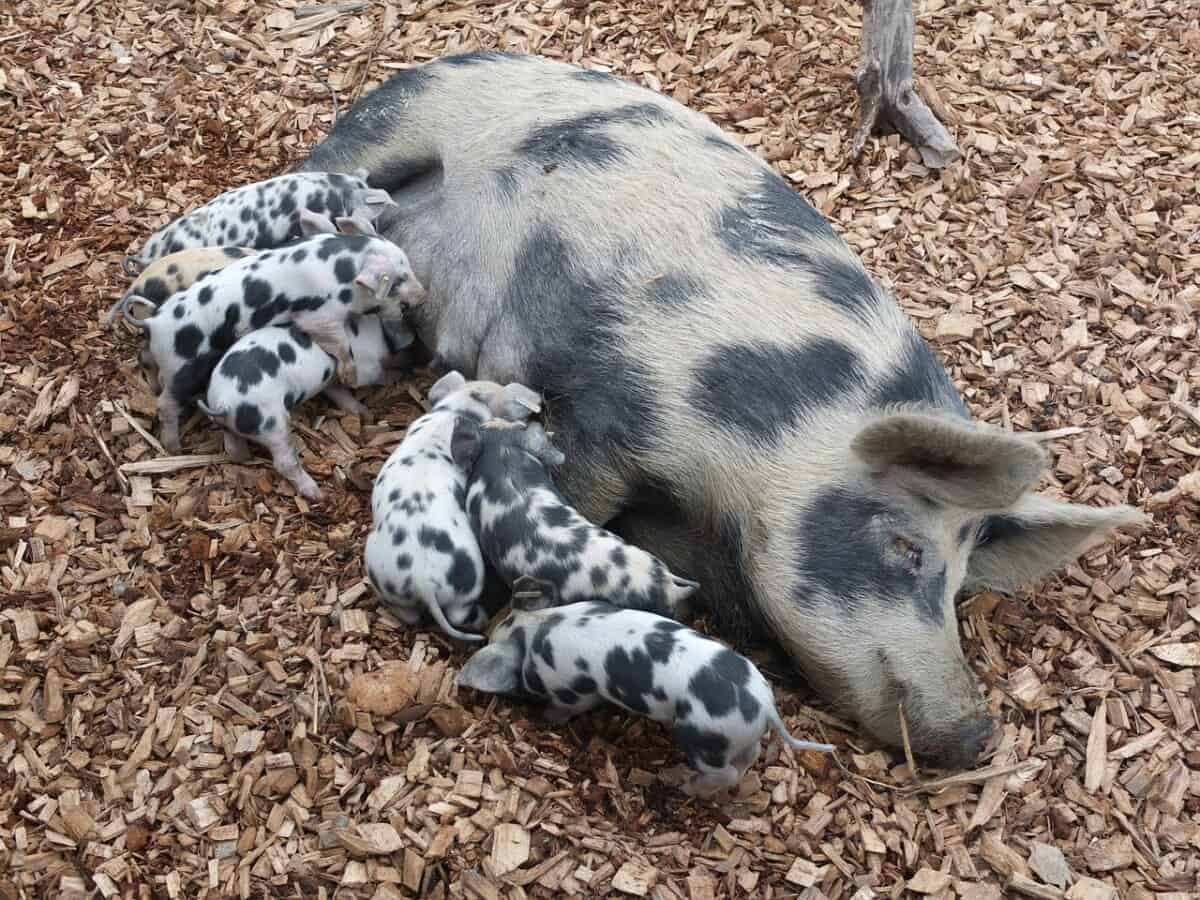The peculiarities of keeping animals depends on the specialisation of the pig farm. Raising pigs on commercial farms is done with the aim of having genetically strong offspring or piglets. Thoroughbred young animals are highly valued if they are able to bred reliably to develop well, strengthen their immune system, and improve the reproductive rates of the swine herd.
You should keep your breeding pigs closest to natural conditions: walking, exercise, and nutrition. Pigs experience great stress when moving from a more favorable environment to industrial complexes. Therefore we would recommend keeping your pigs in more natural settings, there is a reason pigs love to wallow in mud!
Common stress factors are: lack of mobility, limited areas to explore, overcrowding, lack of natural light, frequent change of pen, production noise, intensive reproductive cycles (2-2.5 farrowing cycles per year), which often lead to diseases. Make sure to check out my article on how to best farrow your pigs.
Though we would want our pigs to grow in as wild conditions as possible, pigs are domesticated animals and as such their immune systems are not as robust as their wild counterparts. Raising pigs on breeding farms should take place in a micro-climate, in as sterile environment as possible, while making sure to reduce unnecessary stresses.
For pigs intended for commercial production, you need to create conditions that encourage earlier feed intake from your piglets. This achieves the desired weight of the quickly growing animals at the lowest financial cost.
Methods Of Raising Pigs
Until recently, most pig farms practiced free-range housing. The pens were most often used to provide rest for the pigs, and the processes of feeding and defecation took place on specially equipped areas for this. This method leads to an increase in the size of production areas and to a significant cost of working time for pig breeders.
Pig breeding complexes are actively using the latest industrial feeding technologies, focused on a no-range system of keeping animals. This cost-effective method requires significant changes in the organisation of the technological process.
When building a farm, it is necessary to provide for the division of the area of the pens into zones and think over the technical equipment of the pig-breeding complex.
Modern pens for free-range pigs are equipped with an automated system for dosing and distributing feed, equipment for removing manure, and also provide adequate rest for animals (a dry den, the absence of too loud production noises).
With the floor method, the machines are compactly placed indoors, on hard-surfaced floors. Animals can be kept in them both individually and in groups.
What To Feed Pigs
Three types of feeding are practiced: intensive meat, bacon and greasy. The ration and body condition of the pig depends on the type of feed chosen.
Growing pigs profitably means ensuring a high increase in live weight with low feed costs. With this in mind, let’s look at how we can best do this.
The choice of the type of feeding is influenced by many factors: the breed and age of the animal, timing, quality of feed, weight condition. The selected breed must be suitable for the purpose and type of feeding. The type of pig feeding can be dry or liquid. Feeding continues until the pig reaches the planned live weight. If you’re interested in what the best breeds are for raising pigs, make sure to check out my article here.
With intensive fattening, the rate of increase of live weight is 750-800 g per day. The rations should include all the necessary nutrients: proteins, vitamins, mineral salts. Animals must have free access to food. With a balanced diet, the pigs reach a live weight of 100 kg by 5.5-6 months, and the consumption of feed per 1 kg of gain does not exceed 3.6-3.8 units.
Feed for raising pigs should be highly nutritious, rich in protein. To do this, the diet of a growing animal must contain protein foods: fish and meat waste, whey, churning, meat and bone meal.
Fragrant, juicy and tasty pork, without which it is difficult to imagine a family feast, is getting more expensive every year and many people are now looking at the possibility of raising their own pigs for slaughter, and the quality raises many questions. Breeding pigs at home is quite a profitable business. Even with minimal volumes, pig breeding pays for itself completely.
If you want more information on swine nutrition, make sure to check out my article on that here.
Breeding Your Pigs Effectively
Breeding piglets at home requires knowledge of pig physiology and the characteristics of the breeding process.
It will take at least 5 months before a pig is able to sexually reproduce. Some varieties are 8 months old. Given that at this age the pigs have not yet reached their normal weight, it is necessary to wait for the piglets to fully develop, otherwise you will stunt their growth.
In boars, the optimal weight is considered to be about 180-200 kg (usually observed in one-year-old individuals). In a sow – 130-150 kg (8-9 months). Most pigs can reproduce for between 6-8 years.
Sexual heat occurs several times a year, which is why pigs are called polyester. Estrus in a sow lasts about 18–21 days.
The 7 Stages Of The Pig Breeding Cycle
- Excitation
- Estrus
- Sexual hunting
- Ovulation
- Stable behaviour
- Pregnancy
- Farrowing
Excitation
Restless period lasting up to 2 days. If sows do not find a place for themselves, they may refuse to feed and will start squealing. This can not only be uncomfortable to listen to but it can actually cause your other pigs to be distressed and lead to a lack of productivity.
Estrus
This lasts about 3 days, when mucus is released from the swollen and reddened genitals of the pig. This is the first real physical sign of sexual readiness. If your sows were acting up before and this starts a couple of days later, you can rest easy knowing that the breeding cycle is well under way. If there is no sign of mucus secreting from your sows’ genitals, then it may be time to bring in a vet as there may be other issues at play here.
Sexual hunting
The behavior is comparable to the phase of arousal, alternating with complete immobility. The sow often freezes while urinating. Lasts about 2 days. You will need to make sure that the pig pens you have set up stay sanitary during this phase. Combine this with the previous mucus secretions, this can lead to infections.
Ovulation
This usually occurs within the next 2 days. This is your chance to get your sow pregnant.
Stable behaviour
During the final days of the cycle, the behavior becomes more stable. The sow starts eating. Spills over into pregnancy or, if fertilization has not occurred, lasts until the next estrus cycle.
Pregnancy
Pregnancy lasts about 118 days. If you need more information on birthing piglets, make sure to click on my article here.
Farrowing
Farrowing is quick enough. Usually within 2-6 hours. More than 8 piglets are considered normal. Weight, depending on the quantity, is up to 1.5 kg. The sow’s genitals are restored within 10 days, anything longer and you may need to bring your vet in to examine your sow.
Primary immunity in piglets appears with colostrum, the yellowish liquid produced by the sow. The udder of the sow needs to be thoroughly washed before milking for this liquid. By pressing, a small amount is released, and then the piglets are fed this liquid. Within a week, the composition of the colostrum changes to regular milk and the piglets rapidly gain weight.
In a month, piglets can be transferred to self-feeding, with mandatory drinking with antibiotics. At two months old, young animals for fattening are recommended to be castrated as too many nutrients will be pumped into the development of the genitals rather than fattening your young boars.
Breeding Methods For Your Pigs
In breeding farms, various breeding methods are used to ensure maximum productivity of the resulting offspring. Raising pigs at home is usually somewhat simplified. It is nevertheless necessary to be aware of the existing breeding methods:
Purebred crossing
Pigs of the same breed are allowed for breeding in order to preserve and further improve the traits of piglets. This is a high risk and high reward strategy. You may be more accurately predict how your piglets are born and bred and can build your piggery business around this. But the catch is that your piglets will have less developed immune systems and your vet bills could be much higher as a result.
Crossbreeding
Crossbreeding is used to improve the performance of a certain breed of pig, often to bolster the immune system as mentioned above. To do this, the stock of highly productive producers is consistently infused into it for several generations in a row of other pig breeds.
Reproduction is carried out in order to combine the most valuable characteristics of different breeds in piglets. This can also be a fantastic way to introduce new pig breeds to markets that are not native. They may be great at fattening but maybe can’t handle the heat that your native pigs can. So why not mix them up and see how the crossbred piglets handle it?
Choosing A Pig For Breeding
To breed piglets, it is necessary to select a healthy, mobile, harmoniously developed pig without signs of obesity and a purebred sire. Not necessarily the same breed.
To choose a pig for breeding, you need to carefully read its characteristics. It is desirable that it be:
- Early spring or winter offspring (over the summer you can fatten a young pig to condition on cheap feed, happen in the fall and get piglets for raising pigs by next spring);
- Purebred
- Acclimatised
- Potentially highly productive. More chances if her mother has such qualities as: prolificacy, high milk production, developed maternal instinct.
The pig should have a strong build, a wide chest, close shoulder blades, a straight or slightly arched back, as well as clean, shiny hooves, a maximum number of teats (depending on the breed 5-8 pairs), as well as a normal bite. If you want some more advice on different pig breeds, make sure to check out my article on the subject here!

